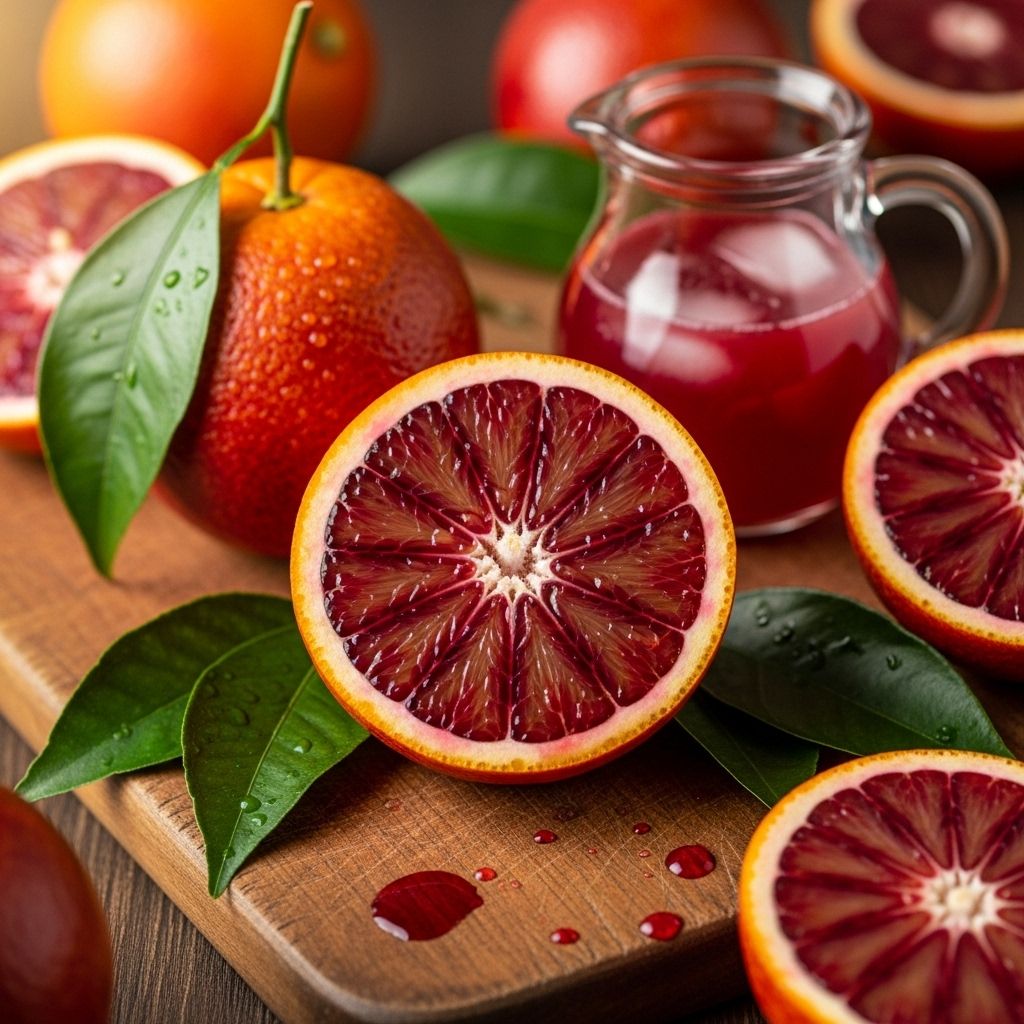Unveiling the Blood Orange: Benefits, Uses, and Taste
Discover the sweet, tart, and nutritious world of blood oranges

Table of Contents
- What is a Blood Orange?
- Benefits of Blood Oranges
- Uses of Blood Oranges
- Taste of Blood Oranges
- Frequently Asked Questions
What is a Blood Orange?
Blood oranges are a variety of sweet orange (Citrus × sinensis) known for their distinctive crimson or blood-red flesh. This unique coloration is due to the presence of anthocyanins, a family of polyphenol pigments that are rare in citrus fruits but common in many other fruits and flowers. The flesh of blood oranges develops its characteristic red color when the fruit grows in environments with low nighttime temperatures, which enhance the accumulation of these pigments. They are often smaller than other types of oranges and have thick, pitted skin that may display a reddish tint. Blood oranges are believed to be a natural mutation of oranges, which are themselves hybrids, likely between pomelos and tangerines.
Benefits of Blood Oranges
Blood oranges are not only visually striking but also offer several nutritional benefits. They are rich in vitamin C, providing about 75% of the recommended daily intake per serving. Additionally, they are good sources of potassium, fiber, and antioxidants, particularly anthocyanins, which contribute to their deep color and have been linked to various health benefits, including antioxidant and anti-inflammatory effects. The antioxidant properties of blood oranges may help protect against oxidative stress and inflammation in the body.
Uses of Blood Oranges
Blood oranges can be consumed in various ways, making them versatile for different culinary applications. They can be eaten fresh, juiced, or used in salads, baked goods, and cocktails. Their sweet and slightly tart flavor, combined with hints of raspberry, makes them a unique addition to both sweet and savory dishes. Blood orange juice is particularly popular in cocktails and dressings, though it should be consumed soon after juicing due to its rapid fermentation.
Taste of Blood Oranges
The taste of blood oranges is distinct from other oranges, offering a sweet and tart flavor profile with subtle hints of raspberry or strawberry. This unique taste, along with their vibrant color, makes them a popular choice for enhancing the visual appeal and flavor complexity of various dishes. Blood oranges are generally less acidic than other oranges, contributing to their sweeter taste.
Common Varieties of Blood Oranges
There are several varieties of blood oranges, each with its unique characteristics and geographic origins:
- Moro: This variety is known for its deep red flesh and is commonly found in the U.S. It is the earliest to ripen but can develop an off-putting flavor if stored too long.
- Tarocco: Originating from Italy, Tarocco oranges have a sweeter and stronger flavor, with less intense red coloration. They remain in season until April.
- Sanguinello: Popular in Spain, this variety has a peel with intense red spots and flesh with burgundy streaks. It ripens later in the season.
Growing and Seasonality
Blood oranges thrive in temperate climates with hot days and cool nights, which enhance the production of their characteristic red pigment, anthocyanin. They are primarily grown in regions like California, Florida, Italy, and Spain’s Mediterranean area. The season for blood oranges generally runs from December to April, with availability varying by region and climate.
Frequently Asked Questions
Here are some answers to frequently asked questions about blood oranges:
Q: What causes the red color of blood oranges?
A: The red color is due to anthocyanins, a pigment developed in response to cooler nighttime temperatures during growth.
Q: Are blood oranges more nutritious than other oranges?
A: Yes, blood oranges are rich in antioxidants and have a higher content of anthocyanins compared to other oranges, which may offer additional health benefits.
Q: How should blood oranges be stored?
A: They can be stored at room temperature or in the refrigerator. Refrigeration helps extend their shelf life.
Q: Can blood oranges be used in cooking and baking?
A: Yes, they are versatile and can be used in salads, baked goods, and as a flavor enhancer in various recipes.
Q: How does the taste of blood oranges compare to other oranges?
A: Blood oranges have a distinct sweet and tart flavor with hints of raspberry, making them sweeter and less acidic than many other oranges.
Q: Are blood oranges available year-round?
A: No, they are generally available from December to April, depending on the region and specific variety.
In summary, blood oranges are a unique and nutritious addition to various culinary dishes, offering not only a striking appearance but also distinct flavor and nutritional benefits.
References
- https://en.wikipedia.org/wiki/Blood_orange
- https://hillstreetgrocer.com/featured-content/articles/bloody-beautiful-all-you-need-know-about-blood-oranges
- http://guide.michelin.com/us/en/article/features/blood-orange-guide-information
- https://askthefoodgeek.com/blood-oranges/
- https://pmc.ncbi.nlm.nih.gov/articles/PMC11482589/
- https://www.rivieraproduce.com/whats-so-special-about-blood-oranges/
- https://www.mccormickfona.com/articles/2019/04/flavor-insight-blood-orange
Read full bio of Sneha Tete












